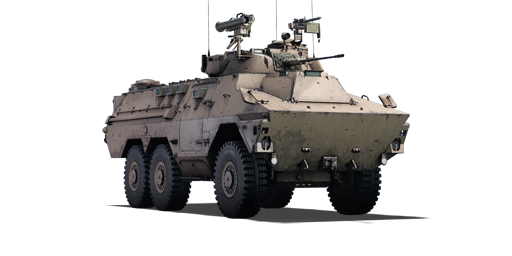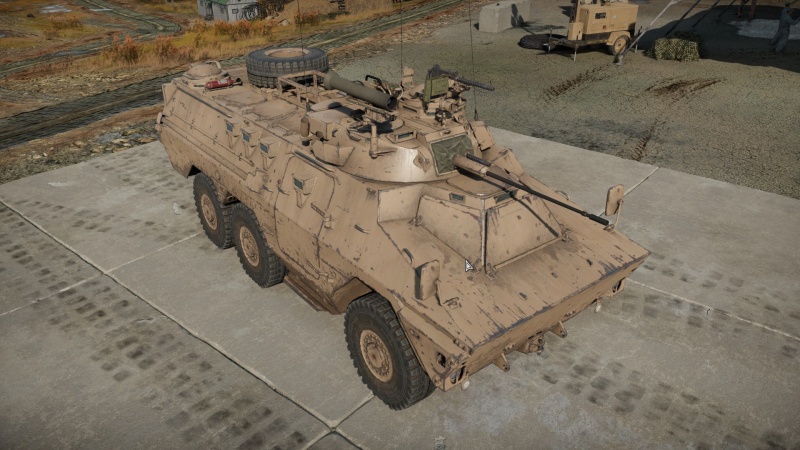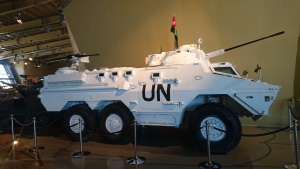Ratel 20
| This page is about the British light tank Ratel 20. For other versions, see Ratel (Family). |
Contents
Description
The Ratel 20 is a rank IV British light tank with a battle rating of 6.7 (AB/RB/SB). It was introduced in Update "Ixwa Strike".
The Ratel 20 is the original variant of the versatile Ratel IFV built by South Africa in 1976, to meet their tactics on mobile warfare. It is granted the title of the first wheeled IFV to enter service worldwide.
While the mobile and indirect playstyle of the previous Ratel 90 continues, the variation in weaponry sets ups for a somewhat more defensive and supporting approach during armoured engagements. The fast-firing 20 mm GI-2 automatic cannon and the powerful Milan ATGM are alternative armaments that will require some practice due to their situational unreliability when compared to a classical high-calibre cannon layout.
Aside from the alternative weaponry, the pros and cons of the Ratel chassis remain essentially unchanged, therefore the Ratel 20 still relies on his firepower and mobility; both are effective tools when in the hands of skilled players.
General info
Survivability and armour
Armour type:
- Rolled homogeneous armour (hull, turret, cupola)
- Cast homogeneous armour (gun mantlet)
- Wheel (tires, suspension rods)
- Bulletproof glass (driver windows)
| Armour | Front (Slope angle) | Sides | Rear | Roof |
|---|---|---|---|---|
| Hull | 15 mm (30°) Front plate 10 mm (75°) Upper Glacis 20 mm (30°) Lower plate |
8 mm (26°) Top 10 mm (2-27°) Bottom |
10 mm (0-43°) | 6 mm |
| Turret | 12 mm (30°) Turret front 12 mm (8°) Gun mantlet |
10 mm (17-21°) | 10 mm (16°) | 10 mm (16°) Front part 10 mm Rear part 8 mm Gunner hatch |
| Cupola | 8-10 mm (spherical) | 8 mm (46-85°) Hatch | ||
Notes:
- Wheels and suspension are 10 mm thick.
- Belly is 8 mm thick.
- Unlike Ratel 90, the radiator's armour is 10mm instead of 5 mm thick.
Mobility
| Game Mode | Max Speed (km/h) | Weight (tons) | Engine power (horsepower) | Power-to-weight ratio (hp/ton) | |||
|---|---|---|---|---|---|---|---|
| Forward | Reverse | Stock | Upgraded | Stock | Upgraded | ||
| Arcade | 117 | 20 | 18.9 | 437 | 538 | 23.12 | 28.47 |
| Realistic | 106 | 18 | 249 | 282 | 13.17 | 14.92 | |
Modifications and economy
Armaments
Main armament
| 20 mm GI-2 | Turret rotation speed (°/s) | Reloading rate (seconds) | ||||||||||||
|---|---|---|---|---|---|---|---|---|---|---|---|---|---|---|
| Mode | Capacity (Belt) | Fire rate | Vertical | Horizontal | Stabilizer | Stock | Upgraded | Full | Expert | Aced | Stock | Full | Expert | Aced |
| Arcade | 1,200 (150) | 750 | -8°/+38° | ±180° | N/A | 22.7 | 31.4 | 38.1 | 42.1 | 44.8 | 10.40 | 9.20 | 8.48 | 8.00 |
| Realistic | 14.2 | 16.7 | 20.2 | 22.4 | 23.8 | |||||||||
Ammunition
- Default: HVAP-T · HEF-I
- M594: HEF-I · HEF-I · HVAP-T
- M601: HVAP-T · HVAP-T · HEF-I
| Penetration statistics | ||||||
|---|---|---|---|---|---|---|
| Belt | Penetration @ 0° Angle of Attack (mm) | |||||
| 10 m | 100 m | 500 m | 1,000 m | 1,500 m | 2,000 m | |
| Default | 57 | 52 | 37 | 24 | 15 | 10 |
| M594 | 57 | 52 | 37 | 24 | 15 | 10 |
| M601 | 57 | 52 | 37 | 24 | 15 | 10 |
Ammo racks
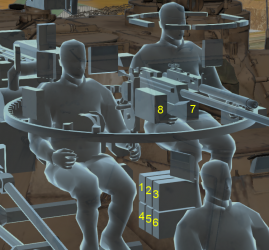
| Full ammo |
Ammo type |
1st rack empty |
2nd rack empty |
3rd rack empty |
4th rack empty |
5th rack empty |
6th rack empty |
7th rack empty |
8th rack empty |
Visual discrepancy |
|---|---|---|---|---|---|---|---|---|---|---|
| 10 1,200 |
Clips Rounds |
9 (+1) 1,080 |
8 (+2) 960 |
7 (+3) 840 |
6 (+4) 620 |
4 (+6) 480 |
3 (+7) 360 |
2 (+8) 240 |
1 (+9) 120 |
Yes |
Notes:
- Ammunition is modelled as 10 clips of 120 rounds.
- The visual discrepancy concerns the number of clips: 10 clips can be fired but only 8 are modeled.
Additional armament
| MILAN missile | |||
|---|---|---|---|
| Capacity | Vertical | Horizontal | Stabilizer |
| 7 | ±5° | N/A | N/A |
Ammunition
| Penetration statistics | |||||||
|---|---|---|---|---|---|---|---|
| Ammunition | Type of warhead |
Penetration @ 0° Angle of Attack (mm) | |||||
| 10 m | 100 m | 500 m | 1,000 m | 1,500 m | 2,000 m | ||
| MILAN | ATGM | 530 | 530 | 530 | 530 | 530 | 530 |
| Shell details | ||||||||||
|---|---|---|---|---|---|---|---|---|---|---|
| Ammunition | Type of warhead |
Velocity (m/s) |
Range (m) |
Projectile Mass (kg) |
Fuse delay (m) |
Fuse sensitivity (mm) |
Explosive Mass (TNT equivalent) (g) |
Ricochet | ||
| 0% | 50% | 100% | ||||||||
| MILAN | ATGM | 200 | 2,000 | 6.7 | 0.05 | 0.1 | 1,830 | 80° | 82° | 90° |
Ammo racks
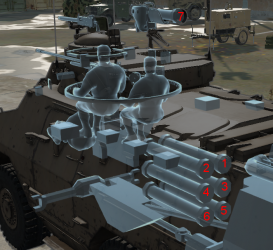
| Full ammo |
Visual discrepancy |
|---|---|
| 7 | No |
Notes:
- Missiles are modeled individually and disappear after having been launched.
- It is not possible to select how many missiles to bring into battle.
- The missiles deplete from 1 to 7.
Machine guns
| 7.62 mm Browning MG4 | ||||
|---|---|---|---|---|
| Mount | Capacity (Belt) | Fire rate | Vertical | Horizontal |
| Coaxial | 3,000 (250) | 500 | N/A | N/A |
| Pintle | 3,000 (250) | 500 | -10°/+3° | ±120° |
Usage in battles
Use your excellent mobility on roads to flank the enemy and use your autocannon to hit side and rear armour. If you ever come face to face with a heavily armoured vehicle, use your ATGM. On rough terrain, support your teammates and use your ATGMs to pick off targets passing by. You can also help repair teammates and destroy lightly-armoured targets with your autocannon. Since your 20 mm isn't very useful against most tanks from the front, use it to take out tracks and gun barrels. The ratel is very long and hard to hide so always be careful that you are not exposing sections of your vehicle that the enemy can see.
Pros and cons
Pros:
- MILAN ATGM has good penetration values and overpressure capabilities
- Ratel chassis is decently mobile once fully upgraded; also great reverse speed of 17 km/h
- 20 mm GI-2 gun has a high rate of fire and a useful elevation of +38°; perfect against low flying aircraft
Cons:
- Large size; difficult to conceal and manoeuvre on urban maps
- No stabilizer; the vehicle must stop to use the GI-2 cannon effectively
- Low engine power; the wheels also struggles on snow, sand or mud
- GI-2 cannon has poor performance against sloped thin armour as those on BMP-1 (Family), R3 T106 FA or AUBL/74
- Armour is unreliable and poor; only 3 crew members and a large ATGMs rack
History
Development
Named after the tenacious honey badger[1], the Ratel Infantry Fighting vehicle’s development began in 1970 when the South African Defence Force required armoured vehicles which could cover vast distances of African plains. These requirements prioritised strong firepower and good protection to enable mechanised infantry to play their role within a highly mobile warfare doctrine. The SADF were already using British APCs, but these aligned with the British doctrine of mobilised infantry dismounting for engagements which was counter-intuitive to the direction of the diverging South African structure [2]. The SADF also used South African designed armoured vehicles, yet these were liable to breakdowns and weapon failures which peaked during the South African Border War, exposing the weaknesses of older and cheaper IFV models and exposing the necessity for complete replacement to the more durable and reliable Ratel models. The South African derivative of the AML, the Eland was successful as a reconnaissance vehicle with remarkable self-defence, and this would inspire the design of the Ratel which shares visual similarity[2].
Combat usage
The Ratel would enter production in 1975 and see immediate success in the Angolan War from 1978. Despite a design based around flat terrain and infantry combat, the Ratel found itself excelling in challenging mountainous terrain and rainforests, fulfilling additional combat and support roles. In later produced modular variants, the Ratel utilised the cannon turret of the Eland, ATGMs and also support platforms such as observation and logistics[3].
The Ratel-20 would see combat in Operation Reindeer, 1978, Operation Sceptic, 1980, Operation Askari, 1983, and Operation Excite, 1988 for the SADF in Angola[2] It still serves several African nations in the present day; including South Africa which maintains over one thousand Ratel IFVs in total comprising a significant percentage of the SADF's land fighting capability; and Ratel-20s have been used extensively by countries participating in United Nations peacekeeping missions[4].
Media
- Skins
- Videos
See also
- Related service history
- Similar Playstyle
External links
Paste links to sources and external resources, such as:
- topic on the official game forum;
- other literature.
| Sandock-Austral | |
|---|---|
| Ratel | Ratel 90 · Ratel 20 · ZT3A2 |
| Eland | Eland 90 Mk.7 |
| Britain light tanks | |
|---|---|
| A13 | A13 Mk I · A13 Mk I (3rd R.T.R.) · A13 Mk II · A13 Mk II 1939 |
| A15 | Crusader II · Crusader "The Saint" · Crusader III |
| A17 | Tetrarch I |
| IFV | Warrior · Desert Warrior (Kuwait) |
| Wheeled | Daimler Mk II · AEC Mk II · Fox · Vickers Mk.11 |
| Other | VFM5 |
| South Africa | |
| SARC | SARC MkIVa · SARC MkVI (2pdr) · SARC MkVI (6pdr) |
| Ratel | Ratel 90 · Ratel 20 |
| Rooikat | Rooikat Mk.1D · Rooikat 105 · Rooikat MTTD |
| Other | Concept 3 · Eland 90 Mk.7 |
| USA | Stuart I · Stuart III |
- ↑ Scheepers, M., Pretorius, F. (2021) 'Loss of military equipment by the SADF at the Battle at Indungo during the Border War, 31 October 1987', Scientia Militaria, South African Journal of Military Studies, Vol 49, Nr 2, pp. 58-9.
- ↑ 2.0 2.1 2.2 Harmse, K., Dunstan, S. (2017) South African Armour of the Border War 1975–89. Oxford: Osprey Publishing, pp. 18-47.
- ↑ O'Malley, T.J. (1996) Fighting Vehicles: Armoured Personnel Carriers and Infantry Fighting Vehicles. London: Merlin Publications, pp. 98-9.
- ↑ Wezeman, P. (2011). 'South African Arms Supplies to Sub-Saharan Africa', Stockholm International Peace Research Institute.


